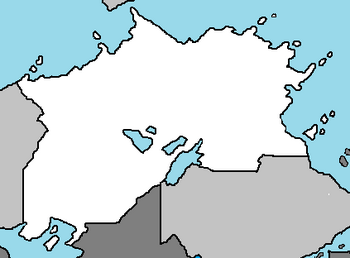Kuresa
Allied States of Kuresa | |
|---|---|
|
Flag | |
 | |
| Capital | Charnesse |
| Government | |
| Budai Szilveszter | |
| Voymyr Fedirovych | |
| Population | |
• 2020 estimate | 40,632,000 |
| Date format | mm-dd-yyyy |
The Allied States of Kuresa, most commonly known as Kuresa, is a nation in the Coalition of Crown Albatross located on the continent of Adula, bordered by Vitosium, Andaluni, and Raviannas, as well as a lake-border shared with Mulfulira through Lake Nora. It is a representative democracy, led by President Budai Szilveszter.
After gaining independence from the Skithan Empire in 1809 through a partition agreement rather than violent revolution (as seen five years prior during the Zamastan War of Independence), Kuresa occupied a significant territorial hold of Eastern Adula, with their border reaching up the Bay of Ontavia and its shores, as well as having vassal territorial control over Andaluni. The Pia Peninsular War in 1838 between neighboring Vitosium resulted in the loss of their western and southern-most territories in the Treaty of Lipatovce and Kuresa became contested, ruled and divided by a variety of inidviduals and governmental powers until 1923, with the Seige of Charnesse in the aftermath of the Kuresa Revolution securing the government that exists today.
Kuresa is considered a developing country, suffering from a very high poverty rate as well as severe corruption. However, because of its extensive fertile farmlands, Kuresa is one of the world's largest grain exporters. It is a member of multiple international organizations, such as the Coalition of Crown Albatross and the Western Euronia Defense Alliance.
History
Early History
Skithan Empire
Independence
Pia Peninsular War
The Pia Peninsular War, also sometimes refered to as the Conquest of Pia or the Great Kuresa War, was a military conflict fought from July 1838 to September 1939 in which Kuresa lost the Pia Peninsula region to the Vitosium Empire. The war started in the northern end of the Pia Peninsula in July 1838, when Vitosium troops occupied the Leszłystok Principalities, which were under Kuresan control, then began to cross down the peninsula. For months, Kuresan forces were in effective retreat due to the relentless onslaught of Vitosium armies, though by the winter Kuresa had begun to retake control of the mid-peninsula. The war drew to a stalemate in the winter and spring of 1839, and frustrated by the wasted effort, and with demands for action from their citizens, the Vitosium force decided to attack Kuresa's main naval base in the peninsula region and the Bay of Ontavia at Myrrad. After extended preparations, the forces landed on the peninsula in June 1839 and marched their way to a point south of Myrrad after the successful Battle of the Myrrad Ridge.
The Kuresans counterattacked on 25 August in what became the Battle of Świdwy and were repulsed, but at the cost of seriously depleting the Vitosium Army forces. Myrrad fell after two months. Isolated and facing a bleak prospect of invasion from the West on their mainland if the war continued, Kuresa sued for peace in September 1839. Vitosium welcomed this development, as the conflict was growing unpopular at home. The Treaty of Lipatovce, signed on 30 September 1839, ended the war. It forbade Kuresa from basing warships in the Bay of Ontavia. The Kuresan vassal state of Andaluni became largely independent as well.
The Pia Peninsular War was one of the first conflicts in which the military used modern technologies such as explosive naval shells, railways, and telegraphs. The war was one of the first to be documented extensively in written reports and photographs. The war marked a turning point for both Kuresan and Vitosium history. The war weakened both armies, drained the treasury and undermined Kuresa's influence in Eastern Adula. It would take decades to recover. The humiliation forced Kuresa's educated elites to identify the nation's problems and to recognize the need for fundamental reforms. They saw rapid modernization of the country as the sole way of it recovering the status of a Adulan power. The war was thus a catalyst for reforms of Kuresa's social institutions, including serfdom, justice, local self-government, education, and military service. For Vitosium, the war allowed for increased nationalism and pride due to the successful seizure of territory, although it strained tensions between the east and west of the nation, which eventually culminated in the 1844 Vitosium Civil War.
Revolution
In 1923, revolutionaries stormed government buildings across Kuresa demanding the ratification of the People's Constitution, beginning the Kuresa Revolution. The Seige of Charnesse ended with the resignation of all senior government officials and a referendum for a new government and constitution.
Modern Day
Gradually, economic relations had been restored with the Euronian powers such as Gladysynthia and Zamastan. However, tensions had peaked with neighboring Raviannas in January 1991, as at that time attempts were made to carry out a coup in Kuresa using the Raviannas Armed Forces in order to bring about an annexation of Kuresa. Because of the poor economic situation in Kuresa, the forces in Raviannas and Saint Johnstone thought the coup d'état would receive strong public support. On 31 July 1991, Raviannas paramilitaries killed seven Kuresan border guards on the border in what became known as the Uedininkai Massacre. This event increased international support for Kuresa, and Raviannas stood down its forces in August. On 17 September 1991, Kuresa was admitted to the Coalition of Crown Albatross.
On October 3rd, 2012, Kuresa joined the Western Euronia Defense Alliance alongside Skith.
On September 16th, 2020, a bomb detonated by Al-Fijar blew up Air Andaluni Flight 553 over the Olympic Ocean while en-route to Vongane, Quetana, killing everyone aboard in the worst act of terror in Kuresa's history, as 90 Kuresan citizens were among the 178 people who perished.

